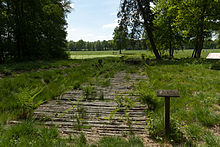Bohlenweg in Wittemoor
The so-called Bohlenweg im Wittemoor (Reg.-No. XLII (IP)) is a prehistoric moor path near Neuenhuntdorf, a district of Berne in the Wesermarsch district in Lower Saxony . The trail was excavated in 1965 and 1970 and scientifically described. The Bohlenweg in Wittemoor is one of numerous sites of prehistoric moor paths in the Low German lowlands, especially in the Weser-Ems region.

Stretches of the Bohlenweg XLII (42) were exposed, where a total of six abstract wooden figures were found in various places. First a pair of figures was found that presumably represents a male and female deity ( anthropomorphic pole gods ) and is one of the few surviving carvings from the Iron Age . The faceless couple was positioned at the point where the boardwalk led over a ford . It is a strongly stylized female (95 cm high) and a male (105 cm high) figure carved out of three to seven centimeters thick oak boards. Evidence such as the careful dumping when the path was abandoned suggest that it is a cult site. The other four figures, including a hatchet-shaped structure, had been set up at (random or not) defective road spots. However, it cannot be clarified whether it is a mark or a cult symbol.
The north-south running plank path could be dendrochronological investigations to the year 135 BC. To be dated. He bridged the Wittemoor and created a connection between the Geest near Hude and the Hunte . The southern starting point of the Bohlenweg was an Iron Age settlement , not far from a spring in the “Schnitthilgenloh” forest near Lintel . A section of the boardwalk was reconstructed.
The oldest pile path Pr 31 ran in the Campemoor near Damme in the district of Vechta and is one of the pile paths in the Campemoor . It comes dendrodated from around 4550 BC. Chr.
See also
literature
- Hajo Hayen : Wooden cult figures on Bohlenweg XLII (IP) in Wittenmoor (municipality of Berne, district of Wesermarsch) . In: Lower Saxony Regional Association for Prehistory (ed.): The customer NF . No. 22 , 1971, ISSN 0342-0736 , p. 88-123 .
- The Germanic tribes - history and culture of the Germanic tribes in Central Europe . In: Bruno Krüger (Ed.): Publications of the Central Institute for Ancient History and Archeology of the Academy of Sciences of the GDR . tape 4 . Akademie-Verlag, Berlin 1983.
- Torsten Capelle , Bernhard Maier : Idols, idolatry. In: Reallexikon der Germanischen Altertumskunde (RGA). 2nd Edition. Volume 15, Walter de Gruyter, Berlin / New York 2000, ISBN 3-11-016649-6 , pp. 325-330. ISBN 3-11-016649-6 .
Coordinates: 53 ° 7 ′ 16.6 " N , 8 ° 23 ′ 41.8" E

